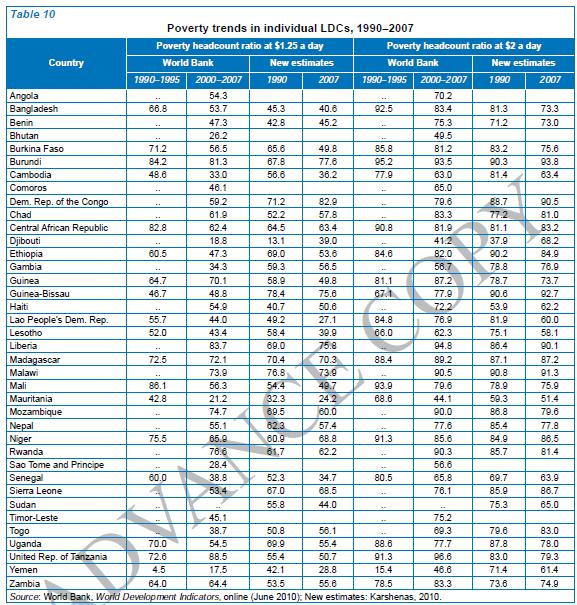The World Bank is the most commonly used source of statistics on poverty. They define poverty as having purchasing power parity (PPP) per capita income from 2005 statistics of less than $1.25 per day. There has been criticism of the 2005 PPP statistics based on the collection of data for China and India from cities and not rural areas. This has been claimed to have underestimated the PPP per capita income by about 27% in China. The University of Pennsylvania is releasing the Penn World Tables 7.0 which correct for that city/rural problem. The World Bank will not have updated PPP data for another 3-4 years. The current World Bank data is adjusted based of the 2005 basis.
If the Penn World Tables 7.0 is correct then the number of poor people in China and India is overestimated by a large amount. The World Bank does not updates its poverty statistics very often and using older estimates the fast economic growth in China and India is likely causing more citizens to not be classified in living in poverty and would effect the global estimates of poverty [This exact case is made by a Brookings Institute analysis which was covered here].
There have been other criticisms of the World Bank data based on the usage of the single PPP metric. The other criticisms if correct might adjust the estimates to indicate that there are more people in poverty.
There is an alternative to the World Bank’s money metric (PPP 2005 $1.25 per day) approach to global consumption poverty estimation. This alternative is simple. It is that the construction of national poverty lines and the design of surveys should be appropriately coordinated through appropriate international standards (on the lines of those applied by the United Nations to the creation of the System of National Accounts) so as to reflect a common meaning of the poverty lines constructed in terms of the resource requirements of essential human achievements. One way of interpreting these achievements is in terms of consumption-dependent basic capabilities. With coordination of poverty line construction (and survey design) across countries, the need for the use of PPPs in poverty assessment would altogether disappear.
Least Developed Country,
Least Developed Country (LDC) is the name given to a country which, according to the United Nations, exhibits the lowest indicators of socioeconomic development, with the lowest Human Development Index ratings of all countries in the world. A country is classified as a Least Developed Country if it meets three criteria:
* low-income (three-year average GNI per capita of less than US $905, which must exceed $1,086 to leave the list)
* human resource weakness (based on indicators of nutrition, health, education and adult literacy) and
* economic vulnerability (based on instability of agricultural production, instability of exports of goods and services, economic importance of non-traditional activities, merchandise export concentration, handicap of economic smallness, and the percentage of population displaced by natural disasters)
The Least Developed Countries Report, 2010 (248 pages, 4 megabytes)
This report has the shift in PPP estimates which reduced China and India’s PPP (from 1990 to 2005) based on only using only city statistics. Only using city statistics has been indicated to underestimate PPP per capita income in China and India and other countries.
Low income and Middle Income country Definitions
Wikipedia on low income countries and developing country definitions.
The World Bank classifies countries into four income groups. These are set each year on July 1. Economies were divided according to 2008 GNI per capita using the following ranges of income:
* Low income countries had GNI per capita of US$975 or less.
* Lower middle income countries had GNI per capita between US$976 and US$3,855.
* Upper middle income countries had GNI per capita between US$3,856 and US$11,905.
* High income countries had GNI above US$11,906.The World Bank classifies all low- and middle-income countries as developing but notes, “The use of the term is convenient; it is not intended to imply that all economies in the group are experiencing similar development or that other economies have reached a preferred or final stage of development. Classification by income does not necessarily reflect development status.
If you liked this article, please give it a quick review on ycombinator or StumbleUpon. Thanks

Brian Wang is a Futurist Thought Leader and a popular Science blogger with 1 million readers per month. His blog Nextbigfuture.com is ranked #1 Science News Blog. It covers many disruptive technology and trends including Space, Robotics, Artificial Intelligence, Medicine, Anti-aging Biotechnology, and Nanotechnology.
Known for identifying cutting edge technologies, he is currently a Co-Founder of a startup and fundraiser for high potential early-stage companies. He is the Head of Research for Allocations for deep technology investments and an Angel Investor at Space Angels.
A frequent speaker at corporations, he has been a TEDx speaker, a Singularity University speaker and guest at numerous interviews for radio and podcasts. He is open to public speaking and advising engagements.


